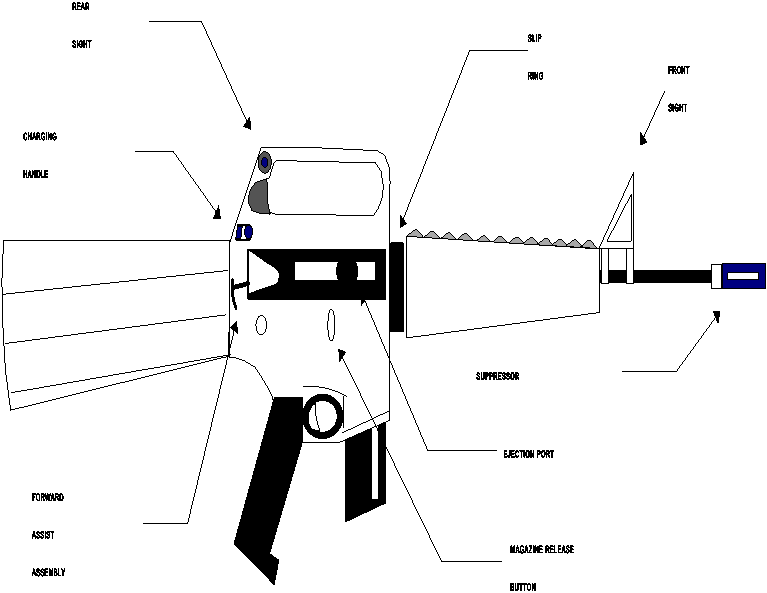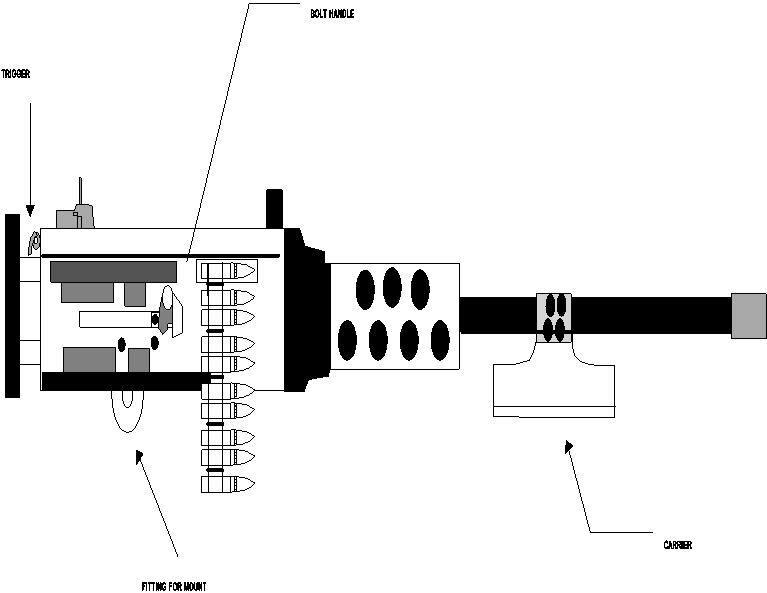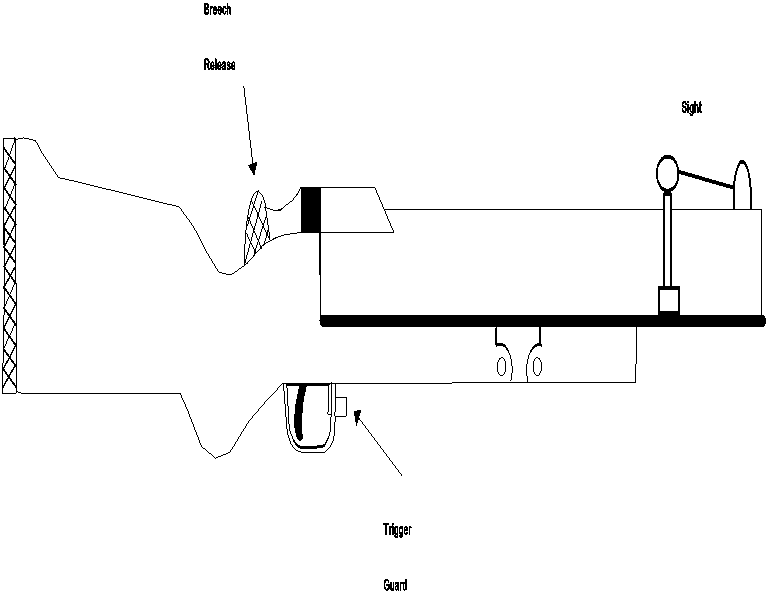 Gunnery Officer
Gunnery Officer  Gunnery Officer
Gunnery Officer SMALL ARMS
Information Sheet Number: 1.20
INTRODUCTION
Small arms custodian is a collateral duty usually assigned to the Gunnery Officer. With such a duty, a relatively high degree of knowledge is required of the ship's arsenal of small arms including: recognition, characteristics, and safety features to facilitate management and training. Occasionally, the Gunnery Officer may be tasked as a range master for small arms qualification, which requires significant knowledge and experience.
REFERENCES
(a) NAVPERS 93863 Marksmanship Manual
(b) OPNAVINST 5530.13 Physical Security of AA&E
(c) NAVSEAINST 8370.2 Small Arms and Weapons Management Policy and Guidance Manual
(d) NAVEDTRA 10185 Gunners Mate G 3&2
(e) NAVSEA OP 3591.1C Shipboard Small Arms Training and Qualification
INFORMATION
A. SMALL ARMS OVERVIEW
1. Small arms comprise those gun-type weapons normally carried and used by infantry personnel and include shoulder-fired rifles, automatic rifles, carbines, pistols, revolvers, machine guns (up to 0.60 inches in caliber), and shotguns.
2. Ammunition for standard navy small arms is obtained from or through the Army Material Command (AMC) whose practices in regard to use, specifications, classes, grades, and markings are followed by the navy.
3. Non-Government Ammunition is not authorized for use in Navy small arms and weapons.
4. The caliber of a small arm is the diameter of the rifled bore measured at the lands. It is expressed in decimal fractions of an inch. For example, a .30-caliber round has a bore diameter of .30 inches.
5. Gauge is used to indicate the internal bore size of shotguns. Gauge represents the number of lead balls of the diameter of the shotgun bore required to weigh one pound. For example, the diameter of the bore of a 12 gauge shotgun is 0.729 inches; 12 lead balls of this diameter weigh one pound.
B. SMALL ARMS CHARACTERISTICS AND SAFETY
1. .45 caliber pistol
a. A recoil operated, semiautomatic, magazine-fed, self loading handgun
b. Magazine: 7 round capacity
c. Effective range: 50 yards
c. Only navy weapon used with left hand rifling
d. Safety mechanisms:
(1) Safety lock (thumb)
(2) Half cock
(3) Grip pressure activated
2. .38 caliber revolver (Smith and Wesson model 110)
a. Lighter than the .45 cal, frequently issued to flight personnel
b. Single action/double action type weapon
c. Effective range: 50 yards
d. Cylinder: 6 round capacity
e. Safety: the hammer block prevents the hammer from going far enough forward to strike the primer.
3. 9mm Pistol. Most fleet units have completed replacing the.45 cal pistol with the 9mm pistol. This pistol is similar to the .45 cal pistol in appearance and operation. Due to staggered round stacking in the magazine, the grip is wider than that found in the .45 cal pistol.
a. A recoil operated, semiautomatic, magazine-fed, self loading handgun
b. Magazine: 13 round capacity
c. Effective range: 50 yards
4. M-14 rifle 7.62MM
a. Gas operated
b. Magazine: 20 round capacity
c. Effective range: 500 yds
d. Semi-automatic or full automatic fire
e. Adaptable with the MK 87 Line Throwing Adapter Kit, the MK 76 Grenade Launcher, the M2 bipod, and the M6 bayonet
f. Safety: on the trigger guard

M-16 A1 Rifle 5.56MM
a. Gas operated
b. Magazine: 20 round capacity
c. Effective range: 1000 yards
d. Semi-automatic or fully automatic fire
e. The M16A1 rifle offers grenade launching capabilities. Grenade launching from the rifle includes pyrotechnics and signal devices, as well as high explosive ammunition.
f. Adaptable to a clothespin type bipod used in the prone and foxhole positions
g. Safety: Selector lever

6. M-60 machine gun 7.62MM
a. Gas operated
b. Used primarily as a support weapon for a rifle company, it supports the rifleman by providing heavy, controlled, and accurate fire beyond the capability of individual small arms.
c. Magazine: Belt fed (100 rds per belt )
d. Effective range: 1200 yards
e. Automatic fire only
f. Equipped with an extra barrel.
g. Safety: Safety lever is located on the left side of the trigger housing. It has an "S" (safe) and an "F" (fire) position.
h. Misfire procedures are IAW OP SW300-BC-SAF-010
7. .50 cal Browning machine gun, heavy barrel
a. Standard army weapon used by the navy in the air, ashore, and afloat
b. Effective range: 2000 yds
c. Semi-automatic or automatic fire
d. Air-cooled, belt-fed, recoil-operated
e. Pre-fire and post-fire checks required

8. Shotgun 12 gage
a. Remington model M870 is used by the navy
b. Manually operated, pump action, magazine-fed (tubular), shoulder fired weapon
c. Magazine: 4 round capacity
d. Effective range: 25 yds
e. Standard ammo is (00) buckshot
f. Safety: cross bolt type

9. M-79 40 MM grenade launcher
a. Single shot, break open type weapon
b. Breech loading and is chambered for a 40MM metallic cartridge with an internal primer
c. Effective range: 350 yards
d. The possibility of a hangfire/misfire and a cookoff exists - Consult the proper tech manual for hangfire/misfire procedures before operating
e. Safety: on the stock assembly

10. Line throwing adapter kit, MK 87 mod 0
a. Consists of six projectiles, one launcher, 18 chemical lights and one recoil pad
b. Uses an M64 grenade cartridge
c. Mod 0 has a soft rubber projectile for lower impact speed and less velocity
d. Gas spindle valve of the M14 rifle must be turned so it is parallel to the weapon, for it to function properly
e. Shot line is orange nylon and comes in 550 ft rolls
f. Armory should have shotline rewinding machine

11. Pyrotechnic pistol MK8
a. Large bore, single shot, break open type
b. Red smoke flare suspended by a parachute for daytime use
c. Attains a maximum altitude of approximately 500 ft with a burn time of about 30 seconds
d. Red star for night time use - Star is rated at 20,000 candle power and is visible at a distance of seven to eight miles
e. Used for signal and identification purposes and may be fired from aircraft or surface
12. 25 MM M242 AUTOMATIC GUN
a. Single barrel, externally powered, automatic gun
b. Rotating bolt driven by a chain drive mechanism
c. Accepts US and NATO steel cased ammunition
d. Designed to engage targets within 2700 yards, such as coastal craft, swimmers, and terrorist craft
e. Capable of firing single shot or up to 175 rounds per minute
Figure 1.20-12 M242 Automatic Gun
C. SMALL ARMS SAFETY PRECAUTIONS
1. Largely a matter of common sense
a. Never point a weapon at anyone unless you intend to shoot them.
b. Never chamber a round unless the user intends to fire it.
d. The safety on every small arm weapon should be on.
e. Consider every weapon to be loaded until verified empty. The empty weapon is the dangerous one.
f. Before firing any weapon make certain there are no obstructions in the bore. Never look down the barrel. Open the breech and look up the barrel (i.e. check for light.)
g. Always use the proper ammo.
h. Make sure the chamber and bore are free of grease and oil.
i. Keep ammo dry, cool and out of direct sunlight. Keep it clean but don't polish it!
j. Do not use dented, loose or corroded cartridges.
k. Misfires and hangfires can occur in small arms. Know the proper procedures as outlined in the weapons technical publication.
D. ACCOUNTABILITY
1. Custody documentation is maintained on custody control cards with form NAVSUP 306.
2. The Weapons Officer, Gunnery Officer, or First Lieutenant usually signs for the ship's small arms and then issues them to respective personnel.
3. At a minimum, small arms are inventoried by serial numbers quarterly, using the R-834 from NSWC, Crane, Indiana. The R834 is updated and verified annually and must be returned within 45 days of receipt.
4. It is recommended that the Gunnery Officer inventory small arms weekly by serial number.
5. NAVSEAINST 8370.2 requires units to conduct both quarterly and monthly inventories by serial number. In addition to the minimum quarterly inventory, inventories must be conducted:
a. Upon relief of the CO
b. Upon relief of the responsible department head
c. Upon relief of the Gunnery Officer
d. Upon ship's commissioning or inactivating
e. Whenever deemed appropriate
6. It is recommended that all armed watches maintain a weapons custody log. The log should be checked daily by the duty Gunners Mate (GM).
7. Equipment logs should be maintained for each type of small arm onboard. The log should include the following:
a. Model
b. Manufacturer
c. Serial number
d. Number of weapons of each type
e. Any repairs or modifications
f. Record of inventories by serial number
E. PHYSICAL SECURITY
1. Armories, arms rooms, and magazines
a. All shall be constructed of a minimum of 14 gage steel.
b. On ships with aluminum superstructure, 1/8" thick bulkheads are required.
c. Bulkheads constructed of double-walled extruded aluminum and aluminum honeycomb type are not acceptable.
d. Bulkheads shall be of all welded construction. Solid core rivets or mechanical fasteners may be used to fasten dissimilar metals.
e. Doors and hatches
(1) Entrances shall be held to a minimum and still provide for safety.
(2) On aluminum hulled ships, designed doors will suffice, however double walled extruded aluminum and aluminum honeycomb constructions are not acceptable.
(3) Doors shall be constructed of a minimum 14 gauge steel. Sheathing of existing doors with 14 gauge steel is acceptable.
(4) A four inch observation port shall be provided in all armory doors.
(5) Armory access doors shall be fitted with an interior locking device that will be in position when the armory is manned.
(6) Door hinges will be installed to render it impossible to remove the closed door. If the hinges are located outside the secured area doors shall be fitted with three brackets. They will be installed on the interior of the door to prevent the door from being opened if the hinges are removed.
(7) Entrances to spaces shall be provided with normal and emergency lighting.
f. Emergency escape scuttle/hatches
(1) Under no circumstances will emergency escape scuttles or hatches be padlocked from the inside.
(2) The outside locking device for emergency scuttles and hatches with permanently installed quick acting double hand wheels shall consist of a hinge box (14 gage steel) with protected hinges or a locking bar. The box shall be secured with an approved high security lock/locking device. This method is also approved for scuttles and hatches with removable handwheels or flush scuttle, operated with a T-wrench.
(3) When the box and padlock are a possible trip hazard, the locking device may be a toggle pin on the inside of the closure constraining movement of the dogging device.
(4) All access locking devices on emergency escape scuttles shall be removed whenever the space is manned.
g. Windows and openings will be protected by three (3) one-quarter inch (minimum) steel bars. No opening will exceed 96 square inches.
h. Locks and hasps
(1) The following locks are approved IAW MIL-H-43905:
(a) Sergeant and Greenleaf 831B padlocks
(b) Style 80R 9 local hasps or model 1300 series high security system
(c) BMR Security Products Corp TAFLOC model 60 self contained flush mounted integral hasp
(d) Sergeant and Greenleaf 826C padlock can be used on topside lockers, except those stowing grenades, high explosives, or incendiary material
F. SMALL ARMS TRAINING
1. The physical security manual requires that all navy personnel who routinely stand armed watches will be qualified in the assigned weapon at least once each calendar year.
2. The following requirements must be completed prior to the assigned duty:
a. As a minimum, formal instruction shall include training on safety precautions, weapon loading/unloading, malfunctions, aiming and firing procedures, characteristics, and the use of deadly force.
b. Shipboard small arms training and qualification requirements are delineated in reference (e) NAVSEA OP 3591.1C. This instruction illustrates range construction, barricades, slug-stops, and watchstander qualification courses of fire for all required shipboard small arms qualifications, including shotgun, rifle, and pistol. Range diagrams are included for every class of ship in the US fleet.